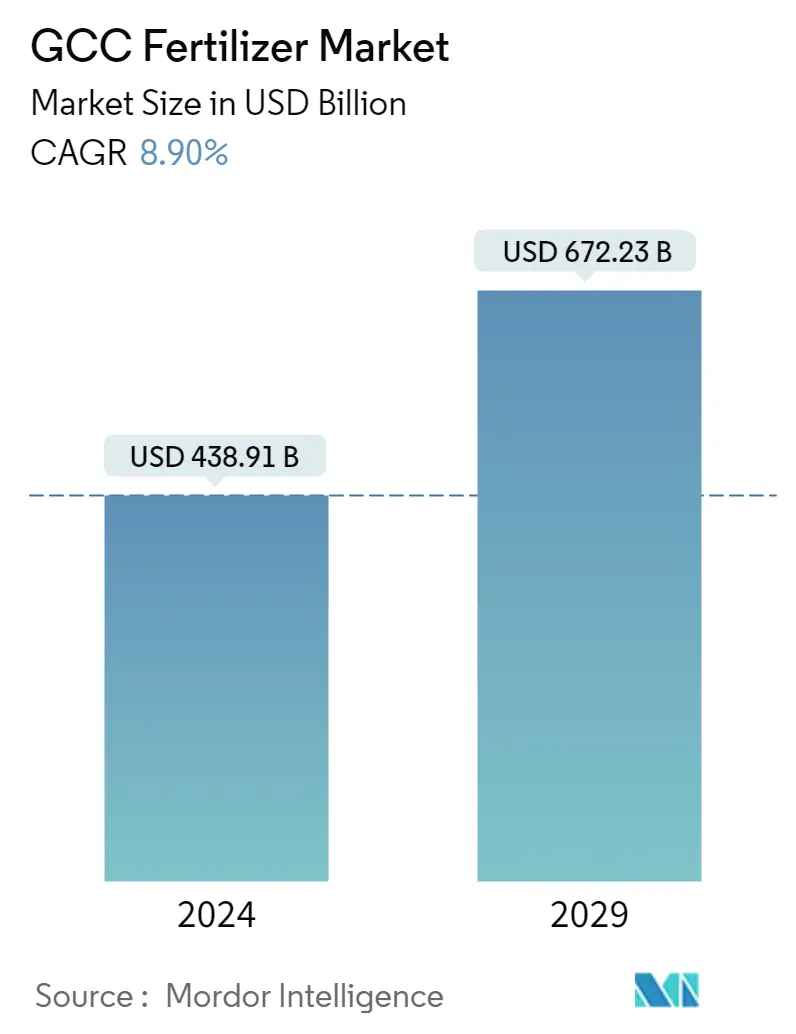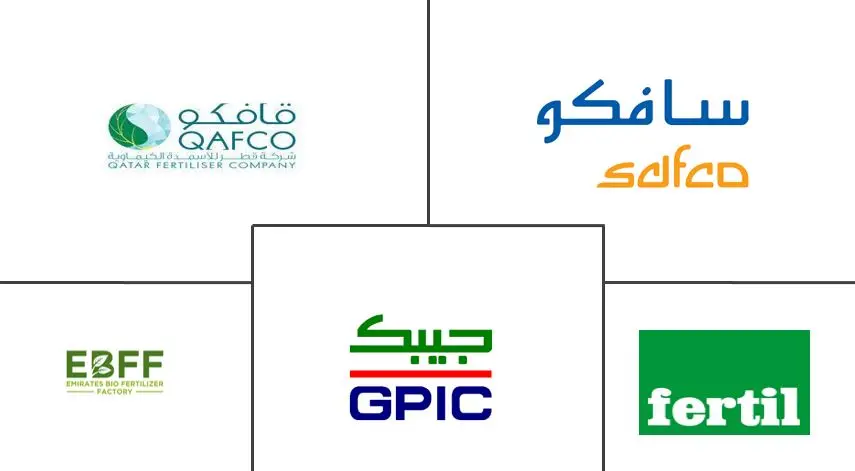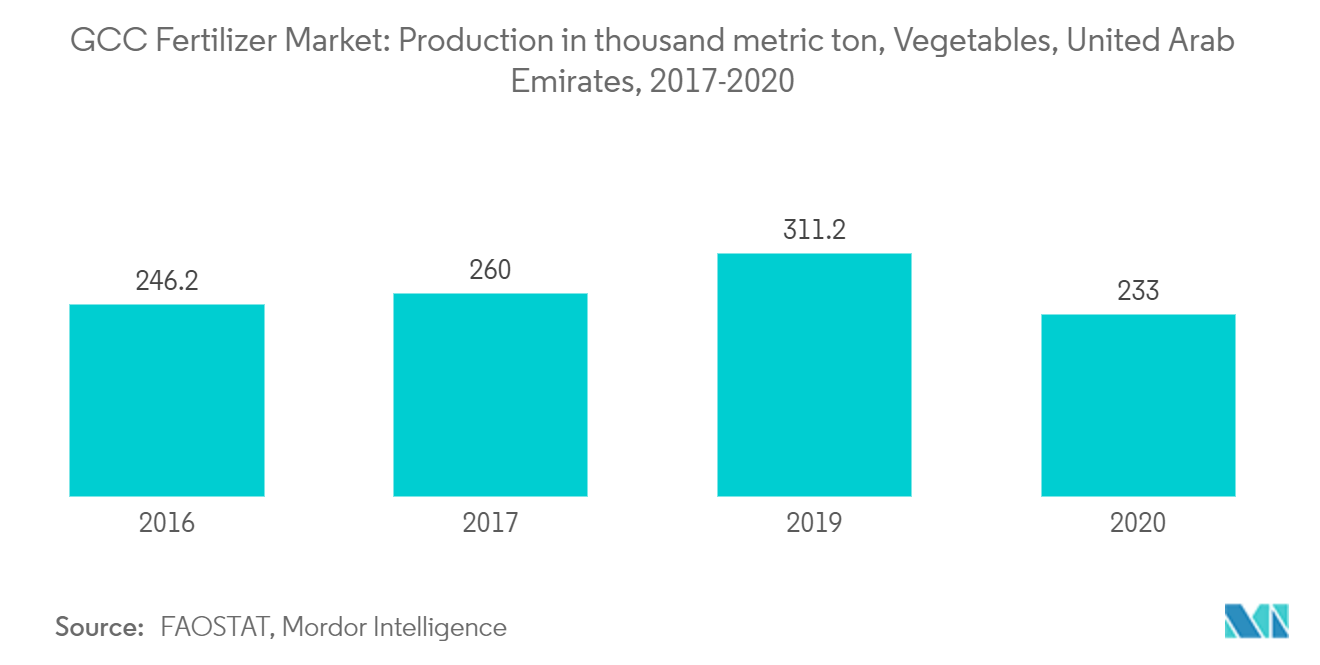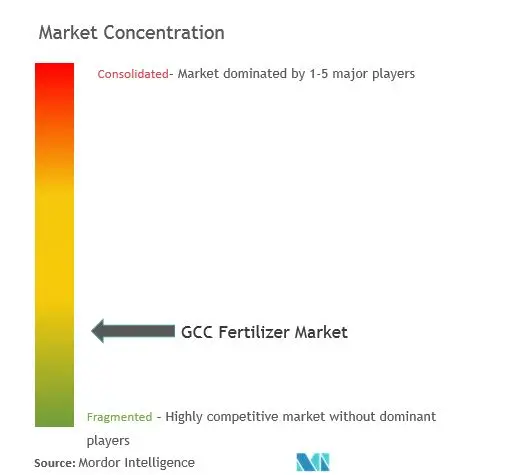GCC Fertilizer Market Size

| Study Period | 2019 - 2029 |
| Base Year For Estimation | 2023 |
| Forecast Data Period | 2024 - 2029 |
| Market Size (2024) | USD 438.91 Billion |
| Market Size (2029) | USD 672.23 Billion |
| CAGR (2024 - 2029) | 8.90 % |
Major Players
*Disclaimer: Major Players sorted in no particular order |
GCC Fertilizer Market Analysis
The GCC Fertilizer Market size is estimated at USD 438.91 billion in 2024, and is expected to reach USD 672.23 billion by 2029, growing at a CAGR of 8.90% during the forecast period (2024-2029).
The COVID-19 pandemic significantly impacted the GCC economy in 2020 due to social distancing measures, national lockdowns, and declining fertilizer prices. The chemical industry in the region is closely linked to economic activity, demand and supply headwinds, fluctuations in feedstock prices, and growth in end-user industries. It experienced the negative implications of the pandemic and the overall economic situation.
Increasing demand for food grains and growing awareness among the farming communities about the use of fertilizers to increase productivity are driving the fertilizer market. Increasing demand for fertilizers from other countries is driving production in the GCC countries. Saudi Arabia contributed 49% to the total fertilizer production of the GCC countries in 2019.
The nitrogenous fertilizer segment occupies a larger chunk of the market. However, the application of potassic fertilizers is growing rapidly, as it may enhance the plants' tolerance to abiotic stress, especially a lack of water, which may significantly reduce crop yields.
Fruit and vegetable production has been growing in the region as governments in the GCC countries are focused on achieving self-sufficiency. Furthermore, the COVID-19 pandemic has emphasized developing local food sources. According to the Food and Agriculture Organization, in 2020, primary fruit and vegetable production stood at 2,913.9 thousand metric ton and 1,052.1 thousand metric ton in Saudi Arabia.
GCC Fertilizer Market Trends
This section covers the major market trends shaping the GCC Fertilizer Market according to our research experts:
Expanding Crop Production Amid Increased Demand for Food Grains
Some major factors favoring the growth of the fertilizer market are the increasing demand for food grains and growing awareness among the farming communities about the use of fertilizers to boost productivity annually, with a growth rate of 10.3%. High population density leading to food scarcity is driving the market's growth. High fertilizer demand from India and Brazil is also stimulating the fertilizer industry's growth in the GCC region.
Currently, Saudi Arabia exports wheat, dates, fruits, vegetables, and flowers to the global market. Dates that were once a staple food of the Saudi diet are now mainly grown for global humanitarian aid. Such initiatives are leading to increased use of fertilizers in crop production. Furthermore, the Saudi government improved its agricultural sector as part of Vision 2030. A top priority for the Kingdom is increasing efficiency in using limited natural resources while developing rural areas.
The modem intensification of agriculture in the country may further increase continuous cropping activities and fertilization due to continuous irrigation. For instance, according to the World Bank data, fertilizer consumption in the United Arab Emirates increased from 708.5 kg per hectare of arable land in 2017 to 745.35 kg per hectare of arable land in 2018. Thus, fertilizer application and demand in the domestic market are expected to increase gradually.

Saudi Arabia is the Largest Producer of Fertilizers
Saudi Arabia and Qatar are major production hubs of ammonia and urea in the region, with DAP production currently available only in Saudi Arabia.
The Kingdom is expected to account for 40% of the GCC ammonia production share and 25% of the GCC urea production by 2024, while Qatar may account for 24% and 34%, respectively. Fertilizers were previously the main export products from the GCC to China. However, with China increasingly focusing on meeting its fertilizer needs, this trade structure virtually disappeared.
As a result, India became the largest export market for GCC fertilizers in 2018, accounting for 27.9% of total exports, followed by the United States, Brazil, Thailand, Australia, and South Africa. The GCC fertilizer industry is evolving and continues to grow as regional producers capture new growth opportunities within and outside the region. The industry remains on a positive growth trajectory with increased production capacity and an evolving product portfolio.

GCC Fertilizer Industry Overview
The GCC fertilizer market is fragmented. Some of the leading players in the market are Qatar Fertilizer Company, Saudi Arabian Fertilizer Company, Gulf Petrochemical Industries Company, Fertil, and Emirates Bio Fertilizer Factory. In February 2017, the Japanese company JGC Gulf International signed an agreement with Gulf Petrochemical Industries Company to produce urea-formaldehyde worth USD 8.8 million.
GCC Fertilizer Market Leaders
-
Qatar Fertilizer Company
-
Saudi Arabian Fertilizer Company
-
Gulf Petrochemical Industries Company
-
Emirates Bio Fertilizer Factory
-
Fertil
*Disclaimer: Major Players sorted in no particular order

GCC Fertilizer Market News
In January 2022, SABIC Agri-Nutrients Company acquired the ETC Group (ETG), with a 49% stake in the ETG Inputs Holdco Limited, for a transaction value of USD 320 million. The agreement is part of SABIC Agri-Nutrients Company's strategy to integrate the value chain and distribution of agri-nutrients markets.
In October 2021, JAS Global Industries expanded its presence in Saudi Arabia by opening a new manufacturing facility in Riyadh. This strategic investment allows JAS to expand its presence and enhance its services in Saudi Arabia.
In 2020, In the United Arab Emirates, Fertil formed a joint venture with OCI's producers in Egypt and Algeria, making it the largest nitrogen-based fertilizer company in the Middle-East and North Africa.
In 2020, Oman India Fertilizer Company SAOC (OMIFCO) was established, an initiative by the Governments of Oman & India, in order to construct, own, and operate a modern world-scale, two-train ammonia-urea fertilizer manufacturing plant at the Sur Industrial Estate in the Sultanate of Oman.
GCC Fertilizer Market Report - Table of Contents
1. INTRODUCTION
- 1.1 Study Assumptions and Market Definition
- 1.2 Scope of the Study
2. RESEARCH METHODOLOGY
3. EXECUTIVE SUMMARY
4. MARKET DYNAMICS
- 4.1 Market Overview
- 4.2 Market Drivers
- 4.3 Market Restraints
-
4.4 Porter's Five Forces Analysis
- 4.4.1 Threat of New Entrants
- 4.4.2 Bargaining Power of Buyers/Consumers
- 4.4.3 Bargaining Power of Suppliers
- 4.4.4 Threat of Substitute Products
- 4.4.5 Intensity of Competitive Rivalry
5. MARKET SEGMENTATION
-
5.1 Product type
- 5.1.1 Nitrogenous
- 5.1.1.1 Urea
- 5.1.1.2 Calcium Ammonium Nitrate (CAN)
- 5.1.1.3 Ammonium Nitrate
- 5.1.1.4 Ammonium Sulfate
- 5.1.1.5 Ammonia
- 5.1.1.6 Other Nitrogenous Fertilizers
- 5.1.2 Phosphatic
- 5.1.2.1 Mono-ammonium Phosphate (MAP)
- 5.1.2.2 Di-ammonium Phosphate (DAP)
- 5.1.2.3 Triple Superphosphate (TSP)
- 5.1.2.4 Other Phosphatic Fertilizers
- 5.1.3 Potassic
- 5.1.3.1 Muriate of Potash (MOP)
- 5.1.3.2 Sulfate of Potash (SOP)
- 5.1.4 Secondary Nutrient Fertilizers
- 5.1.5 Micronutrient Fertilizers
-
5.2 Application
- 5.2.1 Grains and Cereals
- 5.2.2 Pulses and Oil Seeds
- 5.2.3 Fruits and Vegetables
- 5.2.4 Commercial Crops
- 5.2.5 Other Applications
-
5.3 Geography
- 5.3.1 Saudi Arabia
- 5.3.2 Qatar
- 5.3.3 Oman
- 5.3.4 United Arab Emirates
- 5.3.5 Rest of GCC
6. COMPETITIVE LANDSCAPE
- 6.1 Most Adopted Strategies
- 6.2 Market Share Analysis
-
6.3 Company Profiles
- 6.3.1 Qatar Fertilizer Company
- 6.3.2 Saudi Arabian Fertilizer Company
- 6.3.3 Gulf Petrochemical Industries Company
- 6.3.4 Emirates Bio Fertilizer Factory
- 6.3.5 Abu Dhabi Fertilizer Industries Co. WLL
- 6.3.6 RNZ International FZCO
- 6.3.7 Abu Dhabi Fertilizer Industries Co. WLL
- 6.3.8 SABIC
- 6.3.9 RNZ International FZCO
- *List Not Exhaustive
7. MARKET OPPORTUNITIES AND FUTURE TRENDS
8. ASSESSMENT OF IMPACT OF COVID-19 ON THE MARKET
** Subject To AvailablityGCC Fertilizer Industry Segmentation
The scope of the report also includes a comprehensive list of key market players, an analysis of their current strategic interests, and other key information. The GCC fertilizer market is segmented by product type and geography. The report offers market size and forecasts in terms of value (USD million) for the above segments.
| Product type | Nitrogenous | Urea |
| Calcium Ammonium Nitrate (CAN) | ||
| Ammonium Nitrate | ||
| Ammonium Sulfate | ||
| Ammonia | ||
| Other Nitrogenous Fertilizers | ||
| Product type | Phosphatic | Mono-ammonium Phosphate (MAP) |
| Di-ammonium Phosphate (DAP) | ||
| Triple Superphosphate (TSP) | ||
| Other Phosphatic Fertilizers | ||
| Product type | Potassic | Muriate of Potash (MOP) |
| Sulfate of Potash (SOP) | ||
| Product type | Secondary Nutrient Fertilizers | |
| Micronutrient Fertilizers | ||
| Application | Grains and Cereals | |
| Pulses and Oil Seeds | ||
| Fruits and Vegetables | ||
| Commercial Crops | ||
| Other Applications | ||
| Geography | Saudi Arabia | |
| Qatar | ||
| Oman | ||
| United Arab Emirates | ||
| Rest of GCC |
GCC Fertilizer Market Research FAQs
How big is the GCC Fertilizer Market?
The GCC Fertilizer Market size is expected to reach USD 438.91 billion in 2024 and grow at a CAGR of 8.90% to reach USD 672.23 billion by 2029.
What is the current GCC Fertilizer Market size?
In 2024, the GCC Fertilizer Market size is expected to reach USD 438.91 billion.
Who are the key players in GCC Fertilizer Market?
Qatar Fertilizer Company, Saudi Arabian Fertilizer Company, Gulf Petrochemical Industries Company, Emirates Bio Fertilizer Factory and Fertil are the major companies operating in the GCC Fertilizer Market.
What years does this GCC Fertilizer Market cover, and what was the market size in 2023?
In 2023, the GCC Fertilizer Market size was estimated at USD 403.04 billion. The report covers the GCC Fertilizer Market historical market size for years: 2019, 2020, 2021, 2022 and 2023. The report also forecasts the GCC Fertilizer Market size for years: 2024, 2025, 2026, 2027, 2028 and 2029.
GCC Fertilizer Industry Report
Statistics for the 2024 GCC Fertilizer market share, size and revenue growth rate, created by Mordor Intelligence™ Industry Reports. GCC Fertilizer analysis includes a market forecast outlook to 2029 and historical overview. Get a sample of this industry analysis as a free report PDF download.



